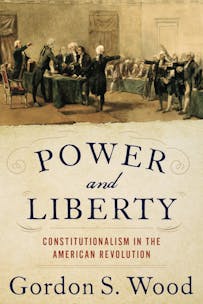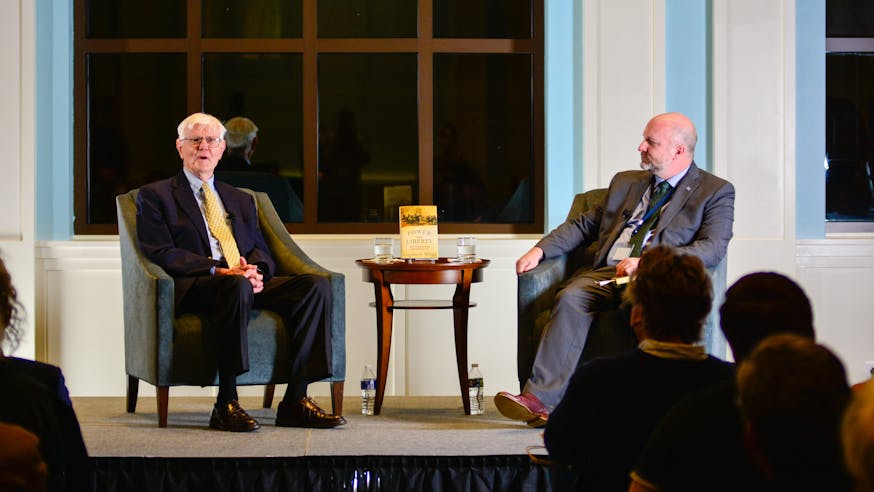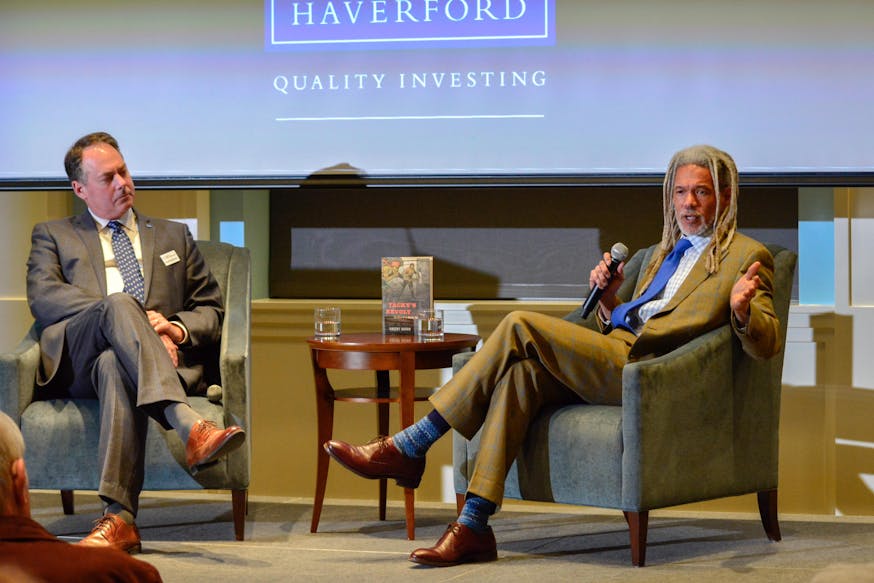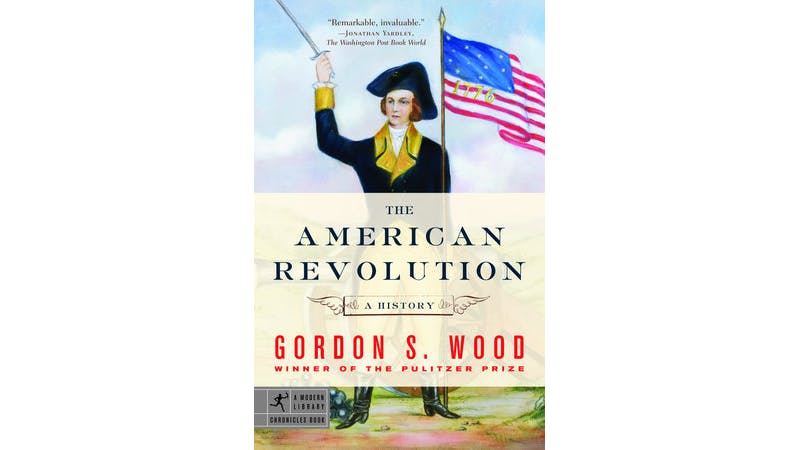Read the Revolution
Power and Liberty
October 20, 2021
Purchase the book from Oxford University Press.
One of the most prominent historians of the American Revolution, Dr. Gordon S. Wood has written numerous books that have changed the course of American historical study, including winners of the Pulitzer and Bancroft Prizes. As the Alva O. Way University Professor and Professor of History Emeritus at Brown University and a Board Member Emeritus of the Museum of the American Revolution, his teaching and mentorship over 50 years continues to influence current and emerging scholarship. Reaching beyond the academy, characters in the 1997 film Good Will Hunting even reference his work while debating the nature of early American economics over drinks at a Harvard bar. In Power and Liberty, Constitutionalism in the American Revolution, Wood distills his research and thinking on the subject into a compact and readable volume.
In this newest book, Wood explores what he calls “the most creative period of constitutionalism in American history and one of the most creative in modern Western history,” the years between the 1760s and the early 1800s. Read an excerpt from Chapter 3: The Crisis of the 1780s to learn how Wood sets up a pivotal moment in American history: the creation of the federal Constitution of 1787. It was an event that, he argues, “in 1776 no one in his wildest dreams ever imagined.”
Excerpt
Yet a brief ten years later, Americans ended up scrapping these Articles of Confederation and creating a totally new and powerful national government in its place. We are apt to assume that the transformation was inevitable, but we should not. It was a momentous change, and one not at all anticipated in 1776. The new government adopted in 1787–88 was not a stronger league of friendship with a few new powers added to the Congress. It was a radically new government altogether—one that utterly transformed the structure of central authority and greatly diminished the power of the several states. The Constitution of 1787 created a national republic in its own right, with a bicameral legislature, a single executive, and an independent supreme court—a government spanning half a continent that, unlike the Confederation, was designed to bypass the states and operate directly on individuals. It created in fact what a decade earlier had seemed theoretically impossible and virtually inconceivable.
Something awful had to have happened in the decade since independence for so many Americans to change their minds so dramatically about what kind of central government they would impose on themselves. What could have happened? What could have compelled Americans to put aside their earlier fears of far-removed political power and create such a strong national government? Today we take the Constitution and a powerful national government so much for granted that we can scarcely doubt its preordained creation. But perhaps we ought to wonder more why the Constitution needed to be created at all.
Nineteenth-century Americans tended to explain the Constitution in heroic terms. John Fiske, in a book published in 1888 for the centennial celebration of the Constitution, The Critical Period of American History, summed up this nineteenth-century thinking. “It is not to much to say,” he wrote, “that the period of five years following the peace of 1783 was the most critical moment in all the history of the American people.” And he made this extraordinary claim in the wake of the Civil War.
Sign Up
Get biweekly Read the Revolution featured excerpts right to your inbox!
Fiske pictured the 1780s as a time of chaos and anarchy, with the country’s finances near ruin. The Confederation government was collapsing and the various state governments, beset by debtor and paper money advocates who were pressing creditor and commercial interests to the wall, were flying off in separate directions. It was a desperate situation retrieved only at the eleventh hour by the high-minded intervention of the founding fathers. These few great framers saved the country from disaster.
The problem with this dominant nineteenth-century interpretation is that there does not appear to have been any near collapse of the economy or any breakdown in society. There was no anarchy, no serious financial crisis, and apparently no real “critical period” after all.
Historical studies of the twentieth century tended to minimize the critical nature of the 1780s. Things seem not to have been as bad as John Fiske and the supporters of the Constitution, or the Federalists, as they called themselves, pictured them. This was the thrust of the work of the twentieth-century Progressive and neo-Progressive historians—beginning with Charles Beard at the start of the century and continuing into the final decades of the century with Merrill Jensen, and his students James Ferguson and Jackson Turner Main. “Clearly,” wrote Ferguson, “it was not the era of public bankruptcy and currency depreciation that historians used to depict.” Both the Confederation and the state governments had done much to stabilize finances in the aftermath of the Revolution. The states had already begun assuming payment of the public debt, and the deficits were not really that serious. To be sure, there was economic dislocation and disruption, but there was no breakdown of the economy. There was a depression in 1784–85, but by 1786 the country was coming out of it, and many of the Federalists were aware of the returning prosperity. The commercial outlook was far from bleak. It’s true that Americans were outside the mercantile protections of the British Empire, but they were freely trading with each other and were reaching out to ports throughout the world—to the West Indies and Spanish America, to the continent of Europe, to Alaska, to Russia, and even to China.
Contrary to Fiske’s assessment, the 1780s were actually a time of great excitement and elevation of spirit. The country was bursting with energy and enterprise, and people were multiplying at a dizzying rate and were on the move in search of opportunities. They were spilling over the mountains into the newly acquired western territories with astonishing rapidity. Kentucky, which had virtually no white inhabitants at the time of independence, by 1780 already had 20,000 settlers.
Despite a slackening of immigration from abroad and the loss of tens of thousands of British loyalists, the population grew as never before or since. In fact, the 1780s experienced the fastest rate of demographic growth of any decade in all of American history. Men and women were marrying earlier and thus having more children—a measure of the high expectations and exuberance of the period. “There is not upon the face of the earth a body of people more happy or rising into consequence with more rapid stride, than the Inhabitants of the United States of America,” secretary of the Congress Charles Thomson told Thomas Jefferson in 1786. “Population is encreasing, new houses building, new settlements forming, and new manufactures establishing with a rapidity beyond conception.” Where did all the talk of crisis come from? “If we are undone,” declared a bewildered South Carolinian, “we are the most splendidly ruined of any nation in the universe.”
There were economic problems, of course, “but,” wrote historian Merrill Jensen, “there is no evidence of stagnation and decay in the 1780s.” In fact, said Jensen, “the period was one of extraordinary growth.” It seems that the bulk of the society was seeking to fulfill the promise of the Revolution, and countless Americans were taking the pursuit of happiness seriously.
If all this is true, and the evidence is overwhelming that it is, then why did Americans create the Constitution? If the Confederation was not doing too bad a job of governing and commercial conditions in the 1780s were not actually desperate, why did something as extraordinary as the Constitution have to be created?
Gordon S. Wood, Power and Liberty: Constitutionalism in the American Revolution (Oxford University Press: New York, NY, 2021), 56-59.
Read the Revolution is sponsored by The Haverford Trust Company.
Read the Revolution is published biweekly by the Museum of the American Revolution to inspire learning about the history of the American Revolution and its ongoing relevance.
Tags
Learn More

WATCH: Read the Revolution with Gordon Wood

Read the Revolution Speaker Series


